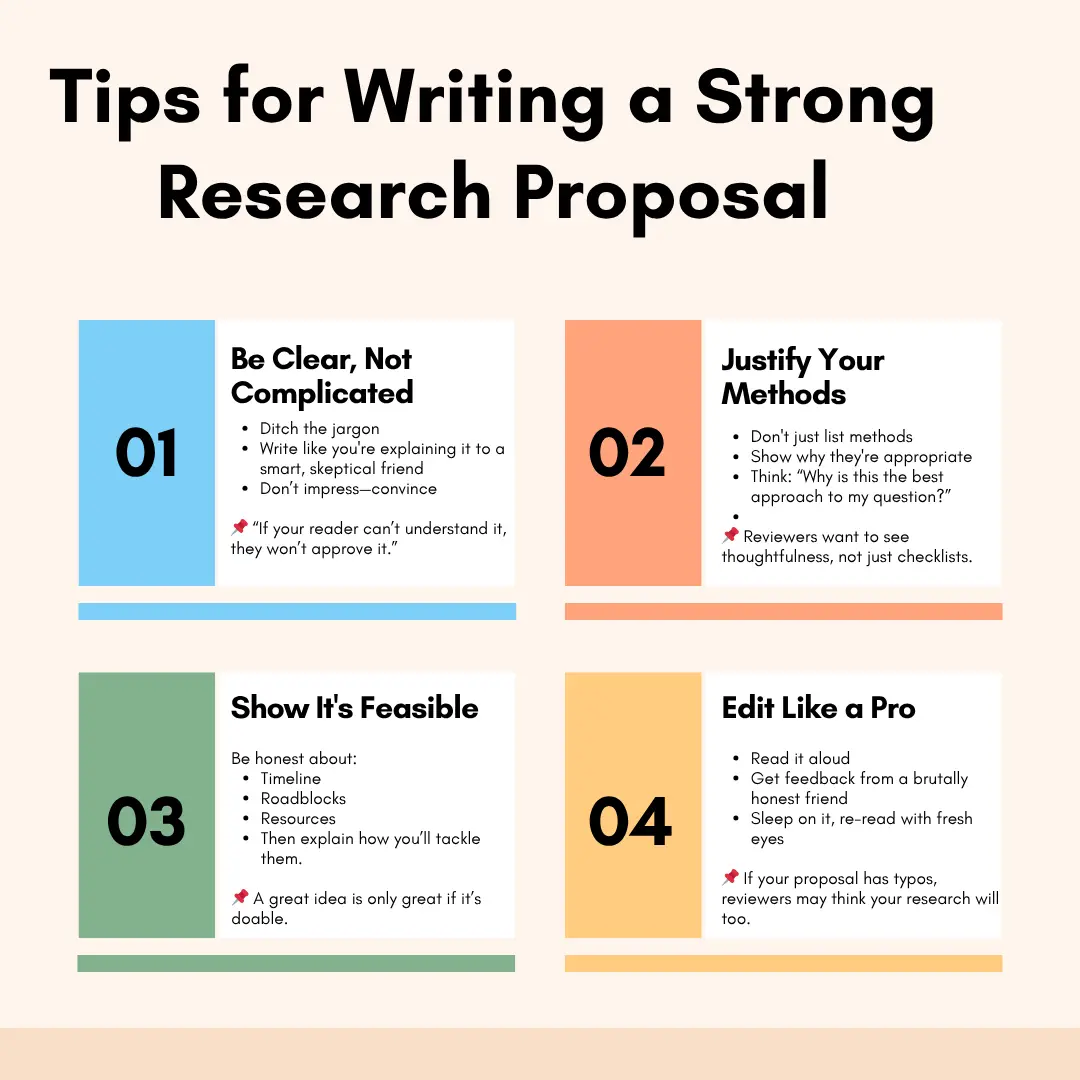Introduction
Think of your research proposal as your project’s blueprint, and your first pitch. Whether you're preparing for a PhD, thesis, or grant, your proposal shows what you're going to study, why it matters, and how you plan to do it.
Done right, it’s more than just a formality. It’s your chance to prove your research idea is both relevant and doable. This guide will walk you through the key sections you’ll need to write a strong, clear, and convincing proposal.
What is a research proposal?
A research proposal is a structured plan that outlines your research question, its significance, and the approach you’ll take to explore it. It’s your way of showing committees, supervisors, or funders that your project is well thought-out and worth supporting.
It’s not just an academic exercise, it’s the first real test of your research idea. A good proposal answers four big questions:
- What are you trying to find out?
- Why does it matter?
- How will you investigate it?
- What could your research contribute?
In short, it’s your research’s CV and action plan rolled into one.
Purpose of a research proposal
While the obvious goal is to get approval or funding, the real value of a proposal is how it sharpens your thinking. Writing one forces you to organize your ideas, spot gaps in your plan, and get clearer about your research goals. Honestly, I’ve lost count of how many “brilliant” ideas fell apart once I tried putting them into words — the process exposes where you need more evidence, better methods, or clearer direction.
For reviewers, it’s a way to assess:
- Whether your topic is original and relevant
- If you’ve done your homework (i.e., read the literature)
- Whether your methods make sense and the project is realistic
- What your research might contribute to the field
A strong proposal doesn’t just explain your project — it builds trust in you as a researcher. When done well, it makes people want to support your work.
How to write a proposal step by step
Writing a research proposal might seem overwhelming at first, but with the right structure, it becomes a powerful tool to clarify your ideas and impress reviewers. Whether you're planning a PhD, thesis, or funding application, this step-by-step guide will walk you through each essential part of the process.
1. Choose a clear and specific topic
Start with a focused research question or theme. A narrow, well-defined topic is easier to manage and more persuasive. Instead of something broad like “AI in education,” try a sharper angle like “The role of virtual agents in language learning.” Tools like ResearchRabbit can help you discover related work and spot meaningful gaps in the literature.
2. Write a working title
Your title should clearly reflect your research focus while staying concise. It sets the tone and gives readers a quick insight into your topic and approach. For example:
“Framing digital humans as team members: A role-based approach to human–AI collaboration”
3. Introduction and problem statement
Introduce your topic and explain why it matters. Then define the gap: What’s missing in the current research? Why now? This is your chance to convince reviewers that your project addresses a timely and important issue.
4. Define your research questions
List your main research question(s) or objectives. Keep them clear, specific, and achievable within your project scope. Strong questions help guide your methodology and keep your proposal focused.
5. Review the literature
Summarize key findings and debates in your field. Show that you’ve done your homework, identified relevant studies, and know where your research fits in. Highlight what’s known, what’s missing, and how your work fills that gap. Visual tools like ResearchRabbit can help map citation networks and discover lesser-known but valuable sources.
6. Describe your methodology
Explain how you’ll conduct the study. Will it be qualitative, quantitative, or mixed? Detail your data collection (e.g., interviews, surveys, experiments), analysis methods, and ethical considerations. Be realistic and show that your plan is feasible and appropriate.
7. Discuss your expected contributions
What will your research add to the field? Will it introduce a new concept, theory, or solution? Make it clear how your work benefits academia or practice, and why that contribution is important.
8. Add a timeline
Outline your research timeline in stages: literature review, ethics approval, data collection, analysis, and writing. A clear timeline shows reviewers that you’ve thought through the process and that your project is doable within the expected timeframe.
9. References
Finish with a list of high-quality academic sources in the correct citation style (APA, MLA, etc.). Make sure your references are relevant, recent, and well-formatted, it signals that your proposal is grounded in credible research.
Research proposal example
Want to see what a complete research proposal actually looks like? Sometimes the best way to learn is by example. We’ve put together a separate guide that walks you through a real sample proposal, complete with title, research questions, methodology, and more. It’s a great way to see how all the pieces fit together in practice.
👉 Check out our full research proposal example
Tips for writing a strong research proposal
Let’s be real, writing a research proposal can feel like trying to impress a panel of experts while blindfolded.
But here’s the good news: you don’t have to sound like an academic robot to get approved.

Clarity beats complexity every time. Ditch the jargon and write like you’re explaining your idea to a smart friend who’s skeptical but curious. And when it comes to methods? Don’t just say what you’ll do, explain why it’s the best way to answer your question. Reviewers aren’t just checking boxes, they’re looking for signs you’ve really thought it through.
Feasibility is your secret weapon.
A brilliant idea means nothing if you can’t realistically pull it off. So be honest about:
- Your timeline
- Available resources
- Potential roadblocks
- Then explain how you’ll handle each.
And please, don’t skip the editing pass. Typos and tangled sentences make reviewers wonder if your research will be just as sloppy. Read it aloud. Send it to a brutally honest friend. Sleep on it, then re-read it with fresh eyes.
How ResearchRabbit can help you
Imagine this: Instead of drowning in a hundred open tabs of half-relevant PDFs, you’ve got an AI research assistant that instantly finds the perfect sources, and even organizes them for you. That’s ResearchRabbit. It’s like having a grad-school best friend who’s read every paper in your field and can point you straight to the gold.
Struggling to frame your research question? ResearchRabbit helps you refine it with AI-powered suggestions. Overwhelmed by citations? It automates the boring stuff so you can focus on the big ideas. It cuts the busywork so you can write a sharper, stronger proposal, without the last-minute chaos.
Conclusion
Your research proposal is the foundation of a successful study. Writing a research proposal doesn’t have to be intimidating. With a clear structure and tools like ResearchRabbit, you can explore existing literature, build your bibliography, and shape a project that’s focused and compelling.




%20(800%20x%201036%20px).png)


This is a big test comment on your article.